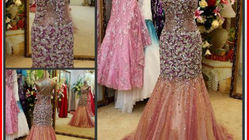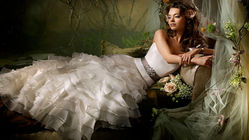Choosing The Perfect Wedding Dress: 7 ways
- YZfashionbridal Inc

- Dec 18, 2013
- 5 min read
One of the most exciting parts of planning your wedding is deciding what you will wear on the big day. Remember to take your mother, a trusted sister or friend with you for an honest opinion and wedding shoes with the same heel size you expect to wear on your wedding day.
Here are some tips to help you choose the perfect wedding dress....
Consider Your Wedding Style
Formal Weddings - a floor-length dress in ivory, white, cream or champagne, with gloves and a train... pure elegance!.
Semi-Formal Weddings - consider pastels, a floor-brushing (ballerina) length, a short veil and no train.
Casual Weddings - a long or short dress, or two-piece suit paired with a classic pillbox hat.
Flatter Your Shape
The best silhouette for the skirt of any dress is A-line.
Try on each wedding dress shape - A-line, princess, ball gown, sheath and empire waist, to see which flatters you the most. Make sure that you can walk, turn, sit and bend comfortably, as well as lift your arms and hug loved ones, without falling out or splitting a seam. Comfort and confidence are crucial on your wedding day!.
If you are short or petite, do not select slim, straight dresses as you may get lost in them. If you like fitted dresses, choose a mermaid skirt which kicks out at the bottom.
For the pear-shaped or hourglass shaped bride, you need to balance the top half of your body with the bottom. You can't go wrong with a strapless (or V-neckline) top and an A-line skirt. Stear clear of straight or bias-cut designs - your hips will be greatly accentuated.
The perfect wedding dress will disguise and draw attention from your least favourite parts and highlight the best.
Wedding dresses are also the subject of fashion, so it's best to choose one that is classic and right for you. Selecting a wedding dress that is at the height of fashion today, may look dated in your wedding photos in years to come.
Compliment Your Skin Colour
Do you have to wear white? ... NO!... but colour does count!. Make sure the colour of your wedding dress compliments the style of your wedding and your body shape. If you have a fuller figure, stay away from bold colours.
More and more brides are going against tradition and wearing coloured dresses.
Few brides go for the pure white wedding dress, because if you don't have the correct skin colouring, it can make you look pastey and be a disaster. Off-white, ivory or creams are easier to wear for most skin tones. More women are chosing dramatic reds, soft pinks and lilacs or pale golds, with black back on the runways of London. If you do go for bold colour, keep the detail to a minimum. What's most important is to choose the one that makes your skin look gorgeous.
Select The Fabric For The Season
Wedding dresses come in a variety of fabrics from very light materials like chiffon and crepe, to satins and silk and heavy brocades. Consider the time of year that you are getting married. You do not want a heavy fabric if you are getting married in summer or on a tropical island and chiffon certainly won't keep the shivers away in winter.
Beadwork is very much in vogue and can transform a simple dress into a stunning bridal gown that will definitely turn heads. Embroidery detail on select areas can can add a bit of colour to you outfit, or draw attention to a particular area of your body (such as the neck and shoulders, away from your hips).
Also think about how wearable the fabric is as you will be sitting, standing and dancing in it all day and night. You don't want it to look creased in all of your photos.
The Neckline For Your Body Shape
The neckline of your wedding dress will draw attention to your upper body. Depending on your body shape and the way you feel about it, your bust, face, neck and shoulders can all be accentuated or downplayed by the shape of the neckline and the top section of your wedding dress. Generally, low round or scooped necks and square necklines suit most brides, do not draw attention to any particular feature and do not detract from your face.
Strapless square or heart-shaped outfits also suit most brides and are very popular. However you need to be confident of the way your shoulders, chest and upper arms look. They look great on shapely girls.
Asymmetric necklines (where the dress has a single strap or irregular shaping) are also very flattering as they help draw the eye away from problem areas such as heavy hips and are becoming more popular in line with current fashion trends.
Large Shoulders - halter necks look best on brides with large shoulders, but may make a woman with a large bust look out of proportion.
Large Busts - V-necks draw attention away from large busts as they guide the eye inwards and down the midline of the dress.
Small Busts - high round neck or slash-neck dresses look best on brides with small busts (it actually makes them appear bigger) or brides that don't want to show too much décolletage.
Train or No Train The train is where the material at the back of the dress extends out. Trains come in various lengths and styles:
Sweep / duster train - the easiest to manage as it extends no more than 50cm from the hem of the dress
Puddle train - is round, begins at the sides of the skirt, making it appear that the bride is standing in a 'puddle' of fabric and it is usually teamed up with a fishtail or column dress in a lighter fabric
Chapel train - usually a metre in length
Cathedral train - usually two or more metres in length
When selecting your train it is important to think about how you will look after it during your wedding day. Although it is the job of your bridesmaid to arrange the train when you have walked down the aisle and for photographs, but the longer and heavier it is, the dirtier it will get and the more difficult it will be for you to cope with and dance.
A detachable train fastened to the skirt near the waist, that can be removed altogether once the ceremony and wedding photos are finished, is the best solution.
One-off Wedding Dresses
If you have visited all your local bridal stores, tried on all their wedding dresses and have not been able to find anything you like, consider having a unique one-ff gown made by a professional dressmaker. Give yourself and the dressmaker time for alterations and fittings - 6 months should do the trick.
The cost of having a one-of-a-kind wedding dress made can vary dramatically depending on the type of dress you want, the detail (such as lace and beading) and the material you select. However, the major benefit is that you will have exactly what you want and know it will be totally unique.
Get recommendations and check the dressmakers references. Most reputable dressmakers are happy to show you samples of their work and put you in contact with brides they have created wedding dresses for in the past.















































Comments